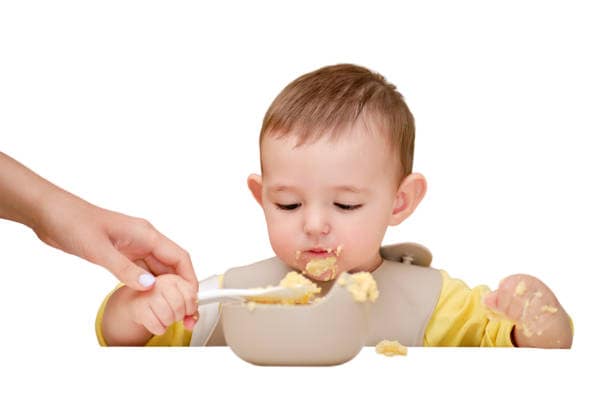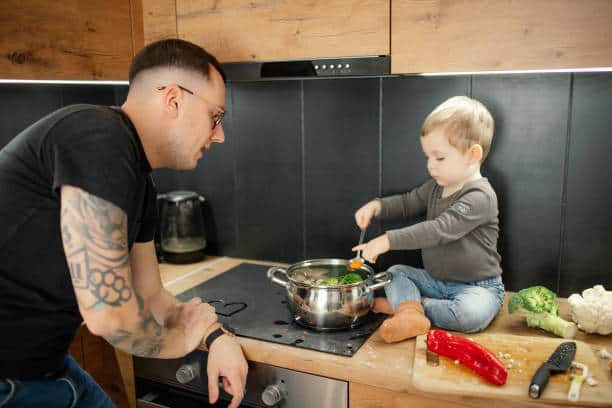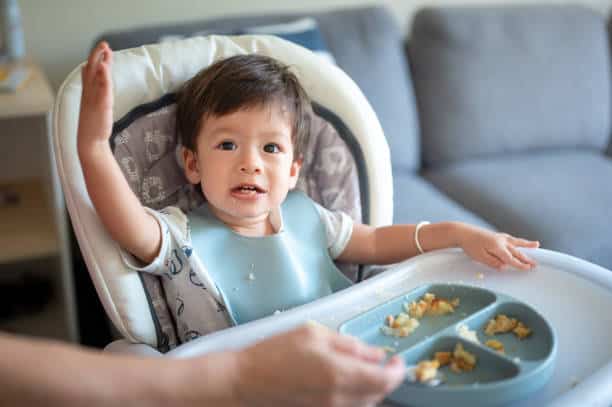Teaching a baby to use a spoon is an important milestone in their development. It allows them to become more independent and develop their fine motor skills.
However, it can be a messy and frustrating process for both the baby and the caregiver. This article will provide tips and techniques for how to teach baby to use spoon?
The first step in teaching a baby to use a spoon is understanding the importance of self-feeding. Self-feeding allows babies to explore different textures and tastes, and it helps them develop their hand-eye coordination.
It also encourages independence and helps them build confidence. It’s important to introduce spoon feeding at the right age and when the baby shows signs of readiness.
This article will provide guidance on identifying the right age and signs.

Key Takeaways
- Self-feeding is an important developmental milestone for babies.
- Spoon feeding should be introduced at the right age and when the baby shows signs of readiness.
- Teaching techniques and choosing the right utensils can help make spoon feeding a successful experience.
1. Understanding the Importance of Self-Feeding

Self-feeding is an important skill that babies need to learn as they grow. It is a key step towards independence and helps to develop their motor skills.
Self-feeding also encourages babies to explore different textures and tastes, which can help them develop a healthy relationship with food.
Mealtime is an important part of a baby’s daily routine, and self-feeding can make it a more enjoyable experience for both the baby and the caregiver. When a baby is able to feed themselves, it gives them a sense of control and independence, which can help to reduce mealtime battles and tantrums.
It is important to introduce self-feeding at the right time. Babies should be able to sit up unassisted and have good head control before they start to learn how to use a spoon.
It is also important to choose the right utensils and dishes that are safe and easy for the baby to use.
In conclusion, self-feeding is an important skill that babies need to learn as they grow. It helps to develop their motor skills, encourages exploration of different textures and tastes, and promotes independence.
By introducing self-feeding at the right time and using appropriate utensils and dishes, mealtime can be a more enjoyable experience for both the baby and the caregiver.
Learn more from another post: How To Teach Baby To Chew
2. Identifying the Right Age and Signs

Teaching a baby to use a spoon is an important milestone in their development. However, it’s crucial to recognize when a child is ready to start using a spoon and not rush the process.
The right age to introduce a spoon to a baby is around 6 to 8 months. At this age, babies start showing interest in solid foods and can sit up with support.
However, every child is different, and it’s essential to observe their readiness signs before introducing a spoon.
Here are some signs to look for:
- The baby can sit up with little or no support.
- The baby is showing interest in solid foods and is opening their mouth when offered food.
- The baby is reaching for objects and bringing them to their mouth.
- The baby is developing their pincer grasp, which means they can pick up small objects using their thumb and forefinger.
It’s important to note that a baby’s motor skills and fine motor development vary. Some babies may take longer to develop hand-eye coordination and pincer grasp, which are essential skills for using a spoon.
In summary, identifying the right age and signs of readiness is crucial when introducing a spoon to a baby. Parents should observe their baby’s development and not rush the process.
By taking the time to introduce a spoon at the right time, parents can help their baby develop the necessary skills to feed themselves independently.
3. Choosing the Right Utensils

When it comes to teaching babies how to use spoons, choosing the right utensils is essential. Here are a few things to keep in mind when selecting baby spoons and other utensils:
Size and Shape
Baby spoons should be small enough to fit comfortably in a baby’s mouth and have a shallow bowl to hold just the right amount of food. Look for spoons with a soft, flexible tip that won’t hurt your baby’s gums.
Forks and other utensils should also be appropriately sized and shaped for little hands.
Material
Baby spoons should be made of safe, non-toxic materials. Many parents prefer spoons made of silicone or other soft materials that won’t hurt baby’s mouth.
Stainless steel utensils are also a good choice as they are durable and easy to clean.
Grip
Look for utensils with easy-to-grip handles that are the right size for your baby’s hands. Some spoons have textured handles that make them easier to hold onto.
Cups and other tools should also be designed with little hands in mind.
Fun Designs
Babies are more likely to be interested in using utensils if they are fun and colorful. Look for spoons and other utensils with bright colors or fun designs that will capture your baby’s attention.
By choosing the right utensils, parents can make the process of teaching babies how to use spoons and other utensils easier and more enjoyable for everyone involved.
4. Preparing the Baby for Spoon Feeding

Before introducing a spoon to a baby, it is important to make sure that they are ready for the transition from breast milk or formula to solid foods. This can be done by exposing the baby to different types of foods and textures, such as baby food, finger foods, cooked noodles, bread, fruit, vegetables, cheese, and crackers.
It is recommended to start with pureed baby food and gradually introduce thicker textures as the baby becomes more comfortable with eating. This can help them develop the necessary motor skills to use a spoon effectively.
In addition to food exposure, it is important to create a positive feeding environment by sitting the baby in a comfortable and secure position, such as in a high chair, and engaging with them during mealtime. This can help them associate mealtime with positive experiences and make them more willing to try new foods.
It is also important to be patient and allow the baby to explore and experiment with the spoon on their own. This can help them develop their own feeding skills and gain confidence in their ability to eat independently.
Overall, by preparing the baby for spoon feeding through food exposure, a positive feeding environment, and patience, parents can help their baby develop the necessary skills to successfully transition to solid foods.
5. Teaching Techniques for Spoon Feeding

Teaching a baby to use a spoon can be a messy but rewarding experience. Here are some techniques that can help make the process more manageable:
Hand Over Hand Method
One way to teach a baby to use a spoon is to use the “hand over hand” method. This involves placing your hand over your baby’s hand and guiding the spoon to their mouth.
This technique can help your baby learn the proper motion and coordination needed to use a spoon.
Start with Purees
When introducing a spoon to your baby, it’s best to start with purees. This will help your baby get used to the sensation of a spoon in their mouth and the taste of different foods.
As your baby becomes more comfortable with the spoon, you can start to introduce more textured foods.
Let Your Baby Explore
Allowing your baby to explore the spoon on their own can help them become more comfortable with it. You can give your baby a spoon to play with during mealtime and let them practice scooping and bringing the spoon to their mouth.
Be Patient
Learning to use a spoon takes time and patience. It’s important to remain calm and patient with your baby during the learning process.
Don’t worry if there are spills and messes along the way – this is all part of the learning experience.
Use Positive Reinforcement
Praise and positive reinforcement can go a long way in teaching your baby to use a spoon. When your baby successfully uses a spoon, give them lots of praise and encouragement.
This will help reinforce the behavior and encourage them to keep trying.
Remember, every baby is different and may learn at their own pace. With these techniques and a little patience, you can help your baby become a pro at using a spoon in no time.
6. Transitioning from Fingers to Spoon

Babies are naturally curious and love exploring their world through touch. When it comes to introducing a spoon, it’s important to recognize that it may take some time for your baby to adjust to using it instead of their fingers.
One effective way to help your baby transition from using their fingers to using a spoon is to incorporate touch during mealtime. Encourage your baby to touch and explore the spoon with their hands before introducing it to their mouth.
This will help them become more comfortable with the utensil and understand its purpose.
Weaning is another important factor to consider when introducing a spoon. If your baby is still breastfeeding or bottle-feeding, it may be helpful to start by offering small amounts of pureed food on a spoon alongside their usual milk feedings.
This will help them become more familiar with the texture and taste of solid foods while still receiving the necessary nutrients from breastmilk or formula.
Baby-led weaning is also a popular approach to introducing solid foods and can be helpful when transitioning to a spoon. By allowing your baby to self-feed with soft, easy-to-grasp foods, they will naturally begin to experiment with utensils and learn how to use them on their own.
When introducing a spoon, it’s important to be patient and offer plenty of opportunities for practice. Try offering a spoon with each meal, even if your baby only uses it for a few bites.
Over time, they will become more comfortable and confident with using a spoon, making mealtime a more enjoyable experience for everyone involved.
7. Avoiding Choking Hazards

When introducing a baby to spoon feeding, it is important to be aware of choking hazards. Babies have a natural reflex to swallow, but they may not be able to coordinate the motion of chewing and swallowing right away.
Here are some tips to help avoid choking hazards:
- Start with smooth and thin purees: When starting out, it is best to feed the baby smooth and thin purees. This will help the baby get used to the texture and learn how to swallow without choking.
- Avoid small and hard foods: Foods that are small and hard can easily get stuck in a baby’s throat. Avoid giving the baby nuts, seeds, popcorn, grapes, and other foods that are difficult to chew and swallow.
- Cut food into small pieces: If you are feeding the baby solid foods, make sure to cut them into small pieces. This will make it easier for the baby to chew and swallow.
- Supervise the baby: Always supervise the baby when feeding. Do not leave the baby alone with food, as they may choke.
- Sit the baby upright: When feeding the baby, make sure they are sitting upright in a high chair or on your lap. This will help the baby swallow more easily and reduce the risk of choking.
- Do not force feed: Do not force the baby to eat if they are not interested or if they are showing signs of distress. This can increase the risk of choking.
By following these tips, you can help ensure that your baby is safe while learning how to use a spoon.
8. Encouraging Independence and Table Manners

Teaching a baby to use a spoon can be a messy and frustrating process, but it’s an important step towards independence and good table manners. Here are some tips to keep in mind:
Start Small
Begin by giving your baby a small amount of food on the spoon, and let them attempt to feed themselves. At first, they may not be very successful, but with practice, they will improve.
It’s important to be patient and not to force the issue, as this can lead to frustration and a negative association with mealtime.
Praise and Encouragement
When your baby makes progress, be sure to offer plenty of praise and encouragement. Positive reinforcement can be a powerful motivator, and it will help your baby feel confident and proud of their accomplishments.
Model Good Table Manners
Babies learn by example, so be sure to model good table manners yourself. Use utensils properly, sit up straight, and avoid talking with your mouth full.
Your baby will be more likely to follow your lead if they see you setting a good example.
Gradually Increase Difficulty
As your baby becomes more comfortable with using a spoon, gradually increase the difficulty level by giving them more challenging foods. For example, you might start with pureed foods, then move on to soft solids, and eventually introduce more complex textures.
Offer Choices
Giving your baby choices can help them feel more independent and engaged in the process. For example, you might offer them a choice between two different types of food or two different utensils.
This can help them feel more in control and more invested in mealtime.
By following these tips, you can help your baby learn to use a spoon while also encouraging good table manners and independence. Remember to be patient and supportive, and to celebrate your baby’s successes along the way.
9. Benefits of Learning to Use a Spoon

Learning to use a spoon is an important milestone for babies as it helps them develop essential skills that are crucial for their growth and development. Here are some of the key benefits of teaching your baby to use a spoon:
Motor Skills Development
Using a spoon requires the development of various motor skills, including gross and fine motor skills. Gross motor skills involve the movement of larger muscle groups, such as the arms and shoulders, while fine motor skills involve the movement of smaller muscle groups, such as the fingers and hands.
By learning to use a spoon, babies can improve their motor skills and coordination, which can help them with other activities such as writing.
Hand-Eye Coordination
Using a spoon also requires good hand-eye coordination, which is the ability to coordinate the movement of the hands with the visual information received by the eyes. This skill is important for many activities, such as playing sports or driving a car.
By practicing using a spoon, babies can improve their hand-eye coordination, which can help them with other activities that require this skill.
Independence and Self-Feeding
Learning to use a spoon can also help babies become more independent and self-sufficient. As they learn to feed themselves, they gain a sense of control over their environment and develop a sense of autonomy.
This can also help them develop their self-confidence and self-esteem.
Socialization and Communication
Using a spoon is also an important social skill, as it is often associated with mealtime and eating with others. By learning to use a spoon, babies can participate in mealtime with their family and friends, which can help them develop their socialization and communication skills.
In conclusion, teaching your baby to use a spoon has many benefits that can help with their growth and development. By improving their motor skills, hand-eye coordination, independence, and socialization skills, they can become more confident and capable individuals.
Related posts: How to Break the Cycle of an Overtired Baby
Frequently Asked Questions
What age should I start teaching my baby to use utensils?
It’s never too early to start introducing your baby to utensils, but typically around 6 to 8 months of age is a good time to start. At this age, your baby will likely be able to sit up and hold objects with their hands.
How can I encourage my baby to use a spoon?
Encourage your baby to use a spoon by offering them foods that are easy to scoop up, such as pureed fruits or vegetables. You can also demonstrate how to use a spoon by scooping up food and bringing it to your mouth.
Let your baby try holding the spoon and scooping up food on their own, even if they make a mess at first.
What are some activities I can do with my baby to help them learn to use a spoon?
One activity you can do with your baby is to offer them a small bowl of dry cereal and a spoon. Encourage them to scoop up the cereal and transfer it from the bowl to their mouth.
You can also offer them foods with different textures, such as mashed potatoes or yogurt, to help them practice using a spoon.
What are the different stages of baby spoons and when should I introduce them?
There are typically three stages of baby spoons: beginner, intermediate, and advanced. Beginner spoons are usually made of soft plastic and have a shallow bowl.
Intermediate spoons have a deeper bowl and are made of a sturdier material. Advanced spoons have a longer handle and a deeper bowl.
You should introduce beginner spoons when your baby is first learning to use utensils, and then gradually introduce intermediate and advanced spoons as they become more skilled.
Why is my baby having trouble using a spoon and how can I help?
Your baby may be having trouble using a spoon because they are still developing their fine motor skills. You can help by offering them foods that are easy to scoop up and by demonstrating how to use a spoon.
You can also try using a spoon with a larger handle or a deeper bowl to make it easier for your baby to hold and scoop.
At what age should my baby be able to use a spoon independently?
Every baby develops at their own pace, but most babies are able to use a spoon independently by around 18 months of age. However, some babies may take longer to develop this skill.
Keep encouraging your baby to use a spoon and offer them plenty of opportunities to practice.

Iesha is a loving mother of 2 beautiful children. She’s an active parent who enjoys indoor and outdoor adventures with her family. Her mission is to share practical and realistic parenting advice to help the parenting community becoming stronger.
